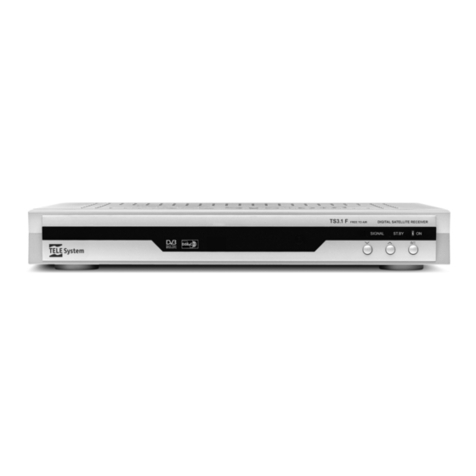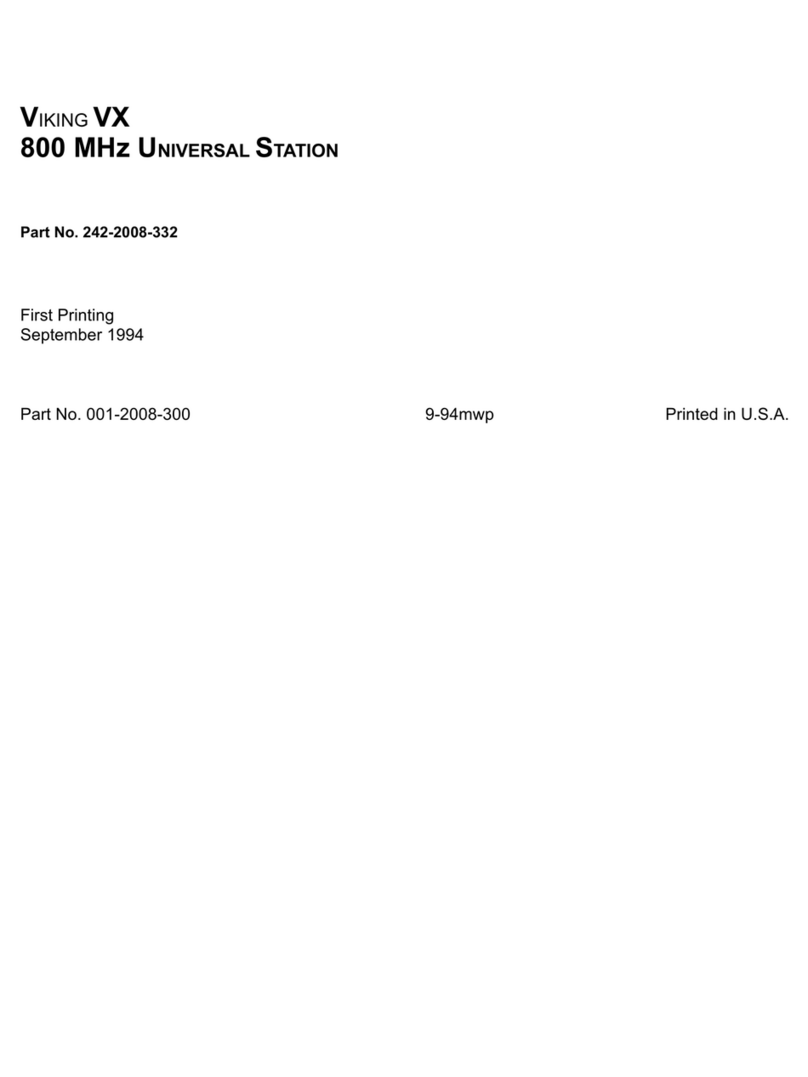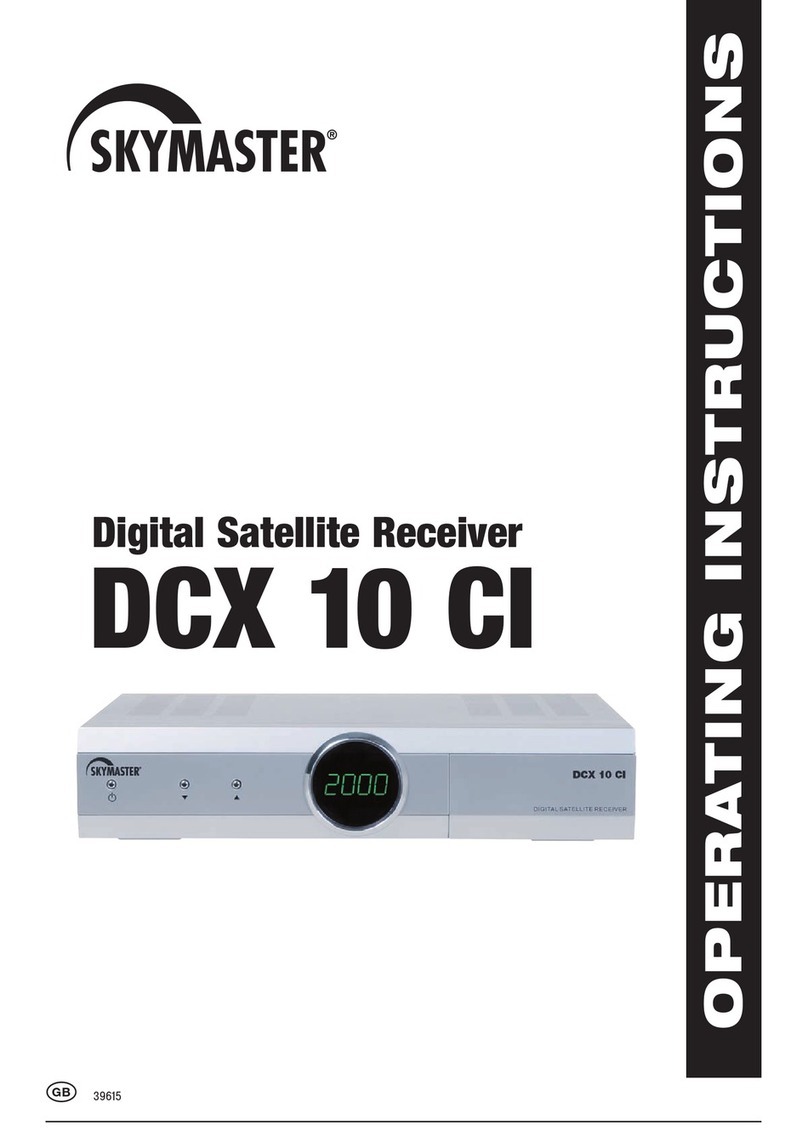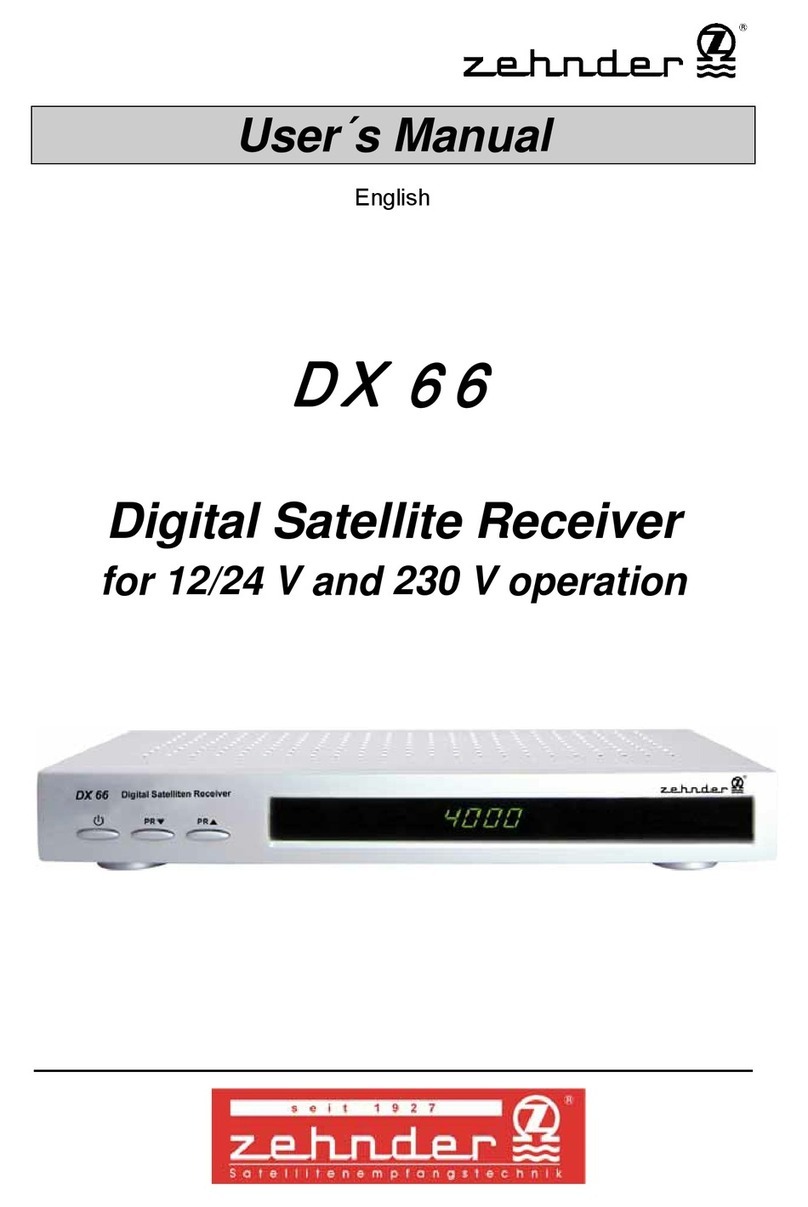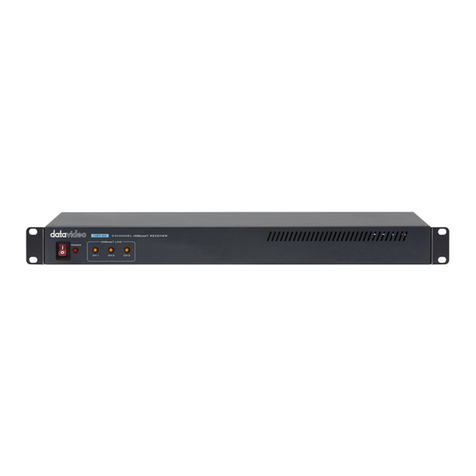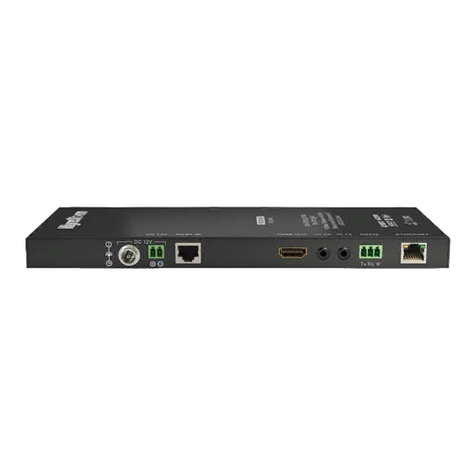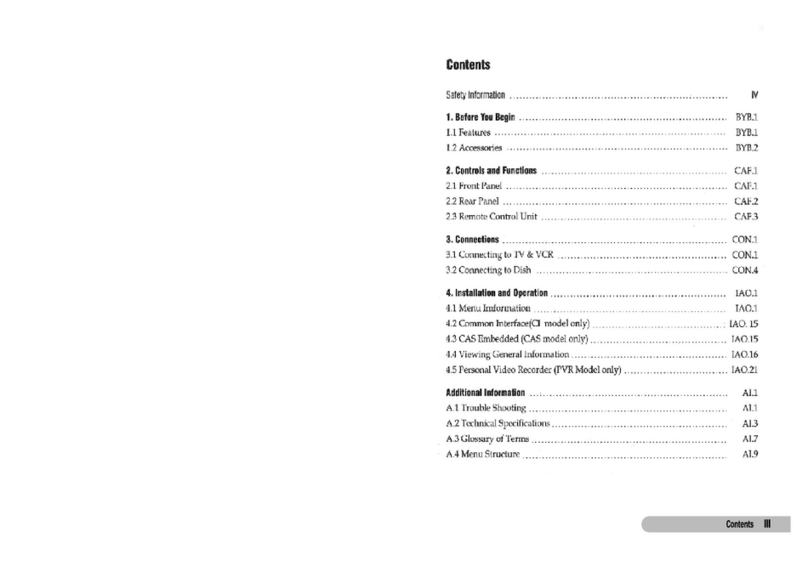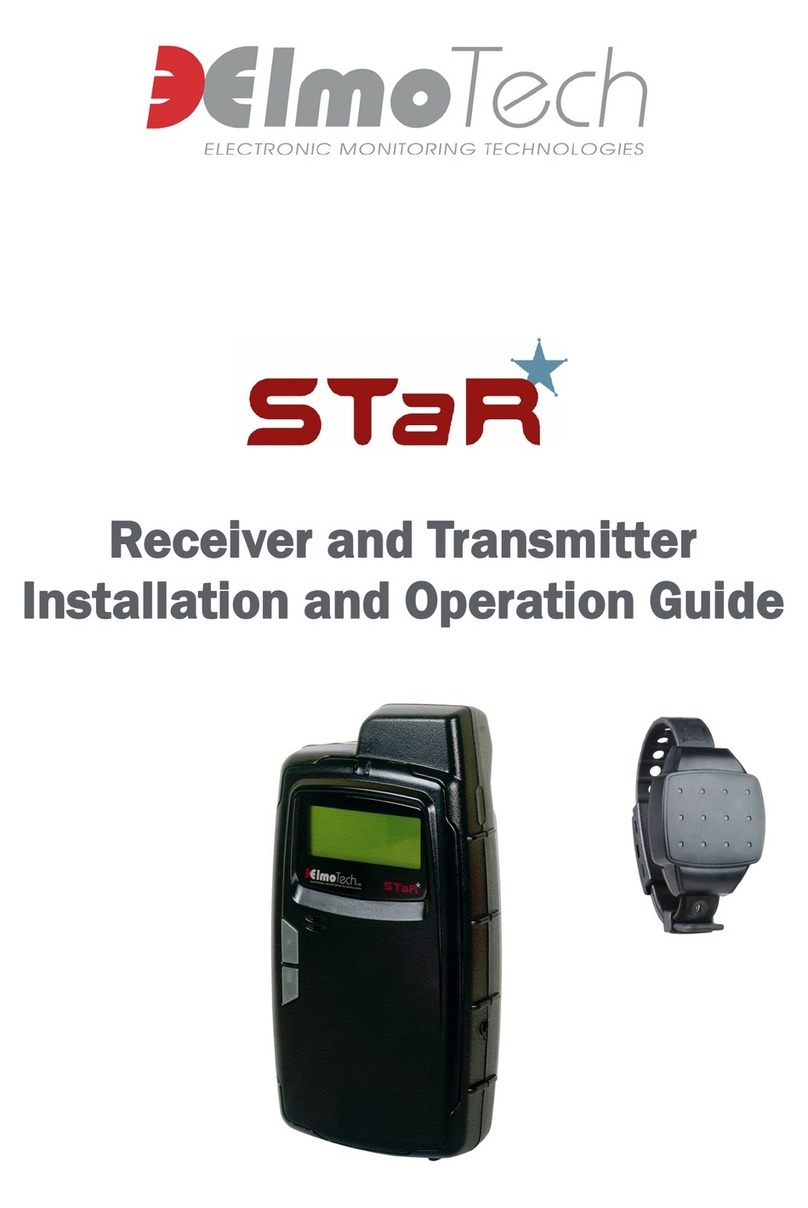Tracker Classic User manual

Classic Receiver

Notes

Congratulations! The Tracker Classic Receiver System will provide
you with state of the art radio-location technology for hunting dogs
and pets. This User’s Guide is intended to provide you with informa-
tion on the functions of the equipment as well as the basics of radio-
location techniques in order to get the most out of your system.
IMPORTANT:
READ ALL INSTRUCTIONS CAREFULLY before operating the receiver.
Warnings:
1. Never operate the unit with a headset at high volume levels
2. Be careful to keep the receiver dry and minimize exposure to
rain, snow or other liquids.
3. Changes or modifications to this receiver, not approved by
Tracker Radio Systems, Inc. could void your authority to operate
this receiver under FCC regulations.
FCC ID: MWBFTV-466
This device complies with part 15 of the FCC rules. Operation is
subject to the following two conditions: 1) This device may not
cause harmful interference, and 2) this device must accept any
interference that may cause undesired operation.

Table of Contents:
Features 1
Receiver Upgrades 2
Integrated Antenna 2
Operating the Receiver 2
Controls 4
Turning ON and OFF 5
Changing Channels 5
Setting the Gain 5
NEAR Mode 5
Frequency Fine Adjustment 5
Plug-ins 6
Automatic Shut-off 7
Changing the Batteries 7
Maintenance 8
Using your System 9
Getting Started 9
Effective Range 13
Advanced Topics and Special Situations 14
Obstacles 14
Signal Bounce 14
Overhead Utilities 15
Use in and around a Vehicle 15
Location of Transmitter 15
Location of Receiver 15
Transmitters 16
Troubleshooting 16
Specifications 19

Features:
• Fixed crystal receiver capable of monitoring a maximum of
two frequencies
• Available in Frequencies ranging from 216 MHz through 220 Mhz
• Manual gain control mode
• Row of 11 LEDs indicate strength of signal
•Near button (attenuator) to assist in locating transmitters at
short distances
• Low battery indicator
• Toggle channel selection button with indicator lights
•Automatic shut-off
• Headphone jack/mute plug
• Patented, virtually unbreakable antenna elements incorporating
steel hinges with 10 year warranty
• Rugged body, CNC milled from a solid aluminum bar and
powder coated
• Splash proof design
Model number and serial number are on left rear antenna.
1

Receiver upgrades:
The Classic is sold as a one or two dog unit. If your receiver was
purchased to monitor a single frequency, you can return the
receiver to Tracker Radio and have a second crystal installed to
monitor a second collar. Charges are assessed for upgrading
and shipping.
CLASSIC RECEIVER
The Tracker CLASSIC receiver is a directional receiver marketed
for a variety of applications including hunting dogs, falconry, pet
tracking, remote control airplanes and model rockets. The anten-
nas fold alongside the body of the receiver to create the most
easily transportable receiver/antenna combination available any-
where in the world.
Below is a review of the important features of the Classic receiver.
Integrated Antenna:
A key feature of the Tracker CLASSIC receiver is the integrated fold-
ing antenna. Tracker antennas feature steel hinges connecting the
antenna elements to the receiver. You will notice that the antennas
are made of virtually unbreakable circuit board material. The
patented design allows the mechanical length of the antenna to be
significantly shorter than the required electrical length.
Operating the receiver:
To use the receiver, first unfold the antennas before activating
the receiver. The receiving antennas are situated on the front of
the receiver and, when fully extended, are perpendicular to the
axis of the receiver. The reflecting antennas are located to the
back and, when fully extended, form a 75 degree angle to the
axis of the receiver. All four elements need to be extended
when tracking.
2

Grasp the receiver in one hand with your thumb close to the
gain wheel. For best results, be careful not to touch the antenna
as you track. In particular, do not allow the rear antennas to rest
on your wrist or forearm, as this can affect the bearing accuracy.
3
Correct way to hold Receiver

4
Signal wheel (not volume)
Low Battery Light for Receiver
Channel Indicators
Channel 1 = red
Channel 2 = green
Channel Button
Signal Strength Lights
OFF Switch
Speaker
Silencer Plug
Not In Use
Near Light
Near Button
ON Switch
Collar Fine Tuner
Controls:
front
back

Operating the Classic Receiver:
Turning the receiver ON:
Press and hold the ON/OFF switch for approximately 1 to 2 sec-
onds. CH 1 will illuminate when receiver is on.
Turning the receiver OFF:
Press and hold the ON/OFF switch for approximately 1 - 2 sec-
onds. All lights will be extinguished when unit is off.
Changing Channels:
Use the CH button to switch between Channel 1 and Channel 2.
The CH1 indication light is red and the CH2 light is green.
Setting the Gain:
The gain should be set carefully in order to detect the transmitter
and to help in direction finding. A gain setting that is too high
will make it difficult to determine a bearing to the transmitter. To
set the Gain, turn the gain wheel to the lowest level where an
audible beep is heard and only green LEDs are illuminated in the
direction of strongest signal. This will provide the most precise
indication of bearing to the transmitter.
Near Mode:
Pressing the NEAR button will activate the attenuator (red light
above button will illuminate). Near mode is useful when seeking
to locate a dog that is less than a 1/2 mile from the receiver.
The NEAR button makes it easier to set the gain level by reduc-
ing the sensitivity.
Frequency Fine Adjustment:
All transmitters exhibit a certain amount of frequency drift based
on temperature and atmospheric conditions. Tracker has incor-
porated an adjustment wheel on the left side of the receiver to
fine-tune the frequency in order to assure maximum distance
tracking and adjusting the pitch of the beep to make it more
audible. To adjust the frequency, select the correct channel and
5

rotate the wheel to maximize the received signal (as indicated by
the LEDs or speaker). The adjustment wheel will modify the
frequency reception for each channel. If tracking two dogs, try to
set the wheel so a strong signal is heard on both dogs.
Headphone Plug/Sound cut-off:
6
Headphone Jack
In: Sound on
Out (1⁄8”): Sound off
Removed: For headphones (internal speaker off when
Headphones/external speaker is used)
The Headphone Jack takes a standard mini (1⁄8") Headphone
Plug (Headphones sold separately) Note that the speaker is OFF
when the Headphones are plugged in. The signal is audible in
both headphone speakers. When removing the plug to allow
the use of headphones, pull straight out. A string fed through
the hole in the plug may help with removal.
IMPORTANT NOTE: Do not attach a ring or other attachment to
plastic plug for purposes of a safety strap. This may cause the
plug to break off requiring factory service. Use metal flange adja-
cent to the headphone jack to attach receiver to holster, belt, etc.

Automatic Shut-off:
The Tracker receiver features an automatic shut-off circuit that will
guard against running down the batteries if the receiver is inad-
vertently left on. Most receivers are set to shut down after 15
minutes if the ON button is not re-pushed.
Changing the Batteries:
1. Start by turning the receiver upside down to allow access to
battery compartment.
2. Loosen the retaining screw on the battery cover and remove
the cover exposing the two 9 Volt batteries.
3. Replace BOTH batteries with 9 Volt batteries of same type
and equal strength. New 9 volt Alkaline batteries are
recommended.
4. Replace the battery compartment cover - start by inserting
forward edge in slot at the front end of the compartment.
5. Tighten the retaining screw.
7

Maintenance:
The CLASSIC receiver is designed to provide years of trouble-free
operation. You can prolong the life of your system by following
these simple suggestions:
1. Store the unit in a dry place at room temperature when not
in use.
2. Minimize the contact with water. Tracker receivers are
among the most water resistant on the market but no unit is
waterproof. Do not store receiver in a wet holster. If unit is
submerged in water or becomes soaked, immediately
remove the batteries and ship unit to Tracker Radio where it
can be chemically cleaned and dried. WARNING: If a
receiver is stored wet and left to dry, pockets of water may
be left under components. This will cause corrosion and
damage, even though unit is working.
3. When batteries are weak, replace BOTH at the same time.
Both batteries should be identical type (9V - non rechargeable,
etc.). Good quality alkaline batteries are recommended.
Rechargeable batteries may be used but, if employed, the low
battery indicator may not provide much, if any, warning.
4. If the receiver becomes soiled, the body and antenna can be
cleaned with alcohol or damp cloth.
5. If the antennas fold in and out with difficulty, DO NOT lubri-
cate. Lubrication requires a special non-penetrating conduc-
tive lubricant and is best accomplished by sending the unit
to Tracker for service.
6. Do not try to adjust the forward/front antennas as it may
cause damage to the circuit board, If forward/front Antennas
are loose (will not stay in the open position), send unit in
for service.
8

USING YOUR SYSTEM
Getting Started
It is important to acquaint yourself with the features of the
receiver before using it in the field. While your system is simple
yet powerful, you will need some time to become proficient in
its use and be able to “read” the signal in different locations.
It is highly recommended that you practice first before taking
your dog hunting.
A Transmitter broadcasts a distinctive pulse in a specific frequen-
cy in all directions. The Classic receives the signal and provides
an indication of the signal strength. The signal strength of the
transmitter detected by the receiver will depend on many factors
such as distance to the transmitter, presence of obstacles, signal
bounce and antenna polarization.
The observed strength of the signal depends on the amplitude
of the wave detected by the receiver. The higher the signal
amplitude, the greater the signal indicated by the Tracker receiv-
er. Radio waves spread in all directions from the source of the
transmission. As the spreading signals travel away for the source
their amplitude decreases and the indicated signal level is
reduced. The antenna’s function is to receive the waves for the
receiver to process. The unique antenna of the Tracker Classic is
designed to favor reception from one direction. When the
Classic is pointing in the direction of the transmitter, the signal
will be stronger.
The degree of difficulty in locating a dog fitted with a radio collar
can vary considerably. Key factors include, landscape, natural
and man-made obstructions (trees, buildings, power lines, etc.)
and weather conditions. These factors influence the strength of
9
HINT: Make sure you take the time to familiarize yourself with
the controls before tracking a transmitter in the field. With a little
practice you will become a proficient tracker.

the signal received, either by attenuating (reducing the strength
of the signal) or creating a reflection that will indicate a “false
position” where the signal will “bounce off” an object.
Understanding how the signal is influenced by these factors will
vastly improve your ability to locate your dog.
To become proficient with the operation of the receiver, you
should consider activating a transmitter, and have someone in
your family or group place it in an open area free from obstruc-
tions (where it can be relocated, if necessary). A good distance
to start would be at least several hundred yards. Turn on the
receiver, select the correct channel and reduce the gain setting
so that only 2 to 3 LEDs (green) are illuminated in the direction
of the strongest signal. Once this is completed, keep the receiv-
er on and walk toward the strongest signal sweeping continuous-
ly in a 180 degree arc that contains the strongest signal. As you
approach the transmitter (indicated by the signal becoming
stronger) continue to reduce the gain (turn knob counter-clock-
wise) so that only a few LEDs are illuminated in the direction of
the strongest signal. If any of the red LEDs are illuminated it is a
signal to reduce the gain. You should quickly locate the transmit-
ter after a little practice. After you become proficient in locating
the transmitter in a flat area (line-of-sight), you are ready to prac-
tice in more challenging landscape.
The speed of the sweep is important. If you sweep too fast, it
will be difficult to get an accurate reading. A steady sweep is
best to start in order to get an initial reading. Once you have an
initial bearing indication, verify that your bearing is correct by
making a few sweeps in other directions. Practice will provide
you with the correct technique.
In the line-of-sight exercise, you should have noted several char-
acteristics of the signal:
• The bearing of strongest signal was consistent.
• The signal strength diminished in a consistent pattern as you
varied 30 or more degrees right or left of the true bearing to
the transmitter.
10

It is important to remember the characteristics of a line-of-sight
situation as it will aid in “reading” the signal in the field.
11
HINT! Pay particular attention to the gain control setting. It is
much easier to track a transmitter when the gain is set at the low-
est setting that yields an audible signal. If you see red LEDs, that
is your indication to reduce the gain.
Figure 1: Typical receiver behavior in line-of-sight situations
Transmitting Collar

Next, repeat the practice procedure in an area similar to your
hunting area (open fields, forested area, etc.). By this point, you
should have mastered the few controls that are required on the
Tracker receiver. This is important as your attention should be
focused on analyzing the signal rather than operating the receiv-
er. If the channel is set correctly and the gain level is set correct-
ly, your attention can then be focused on interpreting the signal.
As you proceed with more complicated searches, it is important
to keep moving as you are processing new data points at each
new location rather than re-sampling the same data point when
stationary.
Follow a similar procedure as in the previous example. Have
someone hide the transmitter in an area that will provide a range
of obstructions (physical and/or man-made). Unfold the anten-
nas, activate the receiver, select the correct channel and deter-
mine if a signal is present. If the signal is heard, slowly sweep
360 degrees to ascertain the direction of strongest signal. You
may notice that you receive a relatively similar strength signal
from two or more directions. Under these circumstances, first
try to ascertain whether a hillside or other obstruction is the
source of the “bounce” signal. While there is no universal
method for analyzing multiple strong signals, try the following
when encountering a “bounce signal candidate:”
• Move to another location some distance away and repeat
the procedure. Try to remember the bearing that you
received strong signals at the first location and note if anoth-
er strong signal comes from a common bearing.
• If you can easily reach a higher elevation (increasing the
odds for a line-of-sight signal), take another reading.
• If the object (house, hillside, etc.) at the source of the
bounce is small, try moving perpendicular to a line between
you and the source of the signal. Often if the angle is
12

changed the strength of the signal will change significantly. If
this occurs, review the initial angle to create a possible candi-
date bearing to the transmitter or eliminate this bearing
(bounce signal).
•Implement a “process of elimination” strategy. If the signal is
difficult to “read” remove from consideration all line-of-sight
locations that you do not receive a strong signal.
You will notice that the signal in the open field led you directly to
the transmitter while in hilly area the bearing changed slightly as
you move around obstacles and hills. This signal “bounce” is
completely normal and eventually, with practice, you will be able
to “read” the signal in relation to the terrain.
A signal is not required to be line-of-sight to yield a good bear-
ing. In gentle rolling topography with few obstructions, radio
waves can follow the contour of the ground and provide a good
bearing. However, distance estimation is complicated as the sig-
nal is attenuated (strength reduced) while following ground con-
tours. Often the bearing will change slightly as you approach
the transmitter across rolling landscape.
EFFECTIVE RANGE
Transmitter and Receiver location will effect the range we can
detect the signal from the transmitter. On flat open country with
few obstructions (trees, large rocks, homes, etc.) we will get
maximum range out of our system. In steep hilly terrain or in a
large city, the range can be reduced significantly.
Distance can be estimated after you have gained experience
tracking in the same terrain using the same transmitter. You may
note that a signal received at a gain level of 6 is much farther
away than one received on a gain level of 5 in the same terrain.
The gain scale is logarithmic not linear. This means the change
13

in gain from 1 to 2 is very small as compared to the change in
gain from 5 to 6, i.e. gain at 1 to 2 is for 50 to 100 ft. while gain
at 5 to 6 is for 1⁄2mile to 2 miles. This is not an exact measure,
the ranges will be different depending on all of the factors
involved. NOTE - If the signal is not line-of-sight, distance esti-
mation is not reliable.
ADVANCED TOPICS AND SPECIAL SITUATIONS
Obstacles
Think about what happens to the signal strength of your favorite
radio station when your vehicle enters a tunnel. Generally the
signal becomes very faint or you lose it altogether. The same
effect can be experienced when searching for a cell phone signal
in a deep canyon. Radio waves at certain frequencies have great
difficulty penetrating rock and other solid objects. Therefore, it is
generally more challenging to locate an object in rugged terrain
rather than on a flat plain.
Signal Bounce
The term that professionals use to describe the behavior of radio
waves deflecting and reflecting off objects is “signal bounce.”
Many different types of substances reflect radio waves including
rock (particularly shear cliffs), water and wet vegetation. “Bounce”
has a tendency to complicate radio-location, as the signal will be
affected by the composition and shape of the reflecting object.
This phenomenon has the potential to create strong signals in sev-
eral discrete directions. Signal Bounce should not be intimidating -
we just need to learn how to manage it.
Polarization
The signal will be strongest when the orientation of the receiver
antenna matches the orientation of the transmitting antenna. For
example, if the transmitting antenna is perpendicular to the
ground, the signal strength detected by the receiver will be great-
est when the antennas are positioned vertically. You can test this
for yourself by activating a transmitter and orienting the antenna
14

on the transmitter parallel to the ground. Then turn on the
receiver and test the signal strength with the antennas parallel
and perpendicular to the antenna on the transmitter. Knowing
the optimal orientation of the receiver can aid in radio-location.
Overhead Utilities
Power lines are excellent re-radiators of radio waves and can
complicate radio-location. Like signal bounce, it is all very man-
ageable once you understand the limitations of tracking near
power lines especially high voltage transmission lines.
Use in and around a vehicle
The receiver can be operated from a motor vehicle, however,
many older vehicles produce considerable interference and
make signal reception difficult (particularly a weak signal) when
the engine is running. When using the receiver without an exter-
nal antenna it is best to shut off the vehicle and move at least
20 feet away. Be cautious of reflected signals off the vehicle. It
might be necessary to take readings from different points from
around the vehicle to get a good bearing.
Location of transmitter
There is a reason why TV and radio transmitters are located on
hilltops and towers - it provides maximum range for the signal.
Conversely, the closer to the ground the transmitter is situated,
the shorter the effective receiving range. Locating an object that
has fallen into a well or is flat on the ground is more difficult
given the reduced effective range of the signal. 15

Location of receiver
Similar to the location of the transmitter, any given signal can be
received at greater distance if the receiving antenna is high in the
air, therefore, a stronger signal may be obtained by positioning
the receiver higher off the ground. NOTE: It is much worse for
the Receiver to be in a depression than the transmitter.
TRANSMITTERS:
For many applications, Tracker markets transmitters with the
Classic receivers, as a package. See the Quick Start Guide for
your transmitter type or download off of www.trackerradio.com
TROUBLESHOOTING:
Receiver will not turn on
1. Make sure you are pressing and holding the ON/OFF button
for at least 1 second.
2. Remove battery cover and check to make sure batteries are
connected and battery clip wires are ok. If wires are broken
or frayed, send unit in for service.
3. Use a battery tester, not a Multimeter/volt meter to assure
that both batteries have sufficient strength.
4. Try replacing batteries. If unit still does not turn on, send unit
in for service.
Receiver is on but no sound is heard from speaker
1. Make sure gain control is set high enough to be able to acti-
vate speaker.
2. Insure the Black Plastic Mute/Silencer plug is all the way in
the Headphone Jack.
3. Remove the plug.
4. If there is still no sound from the internal speaker, send unit
in for service.
16
Table of contents
Popular Receiver manuals by other brands
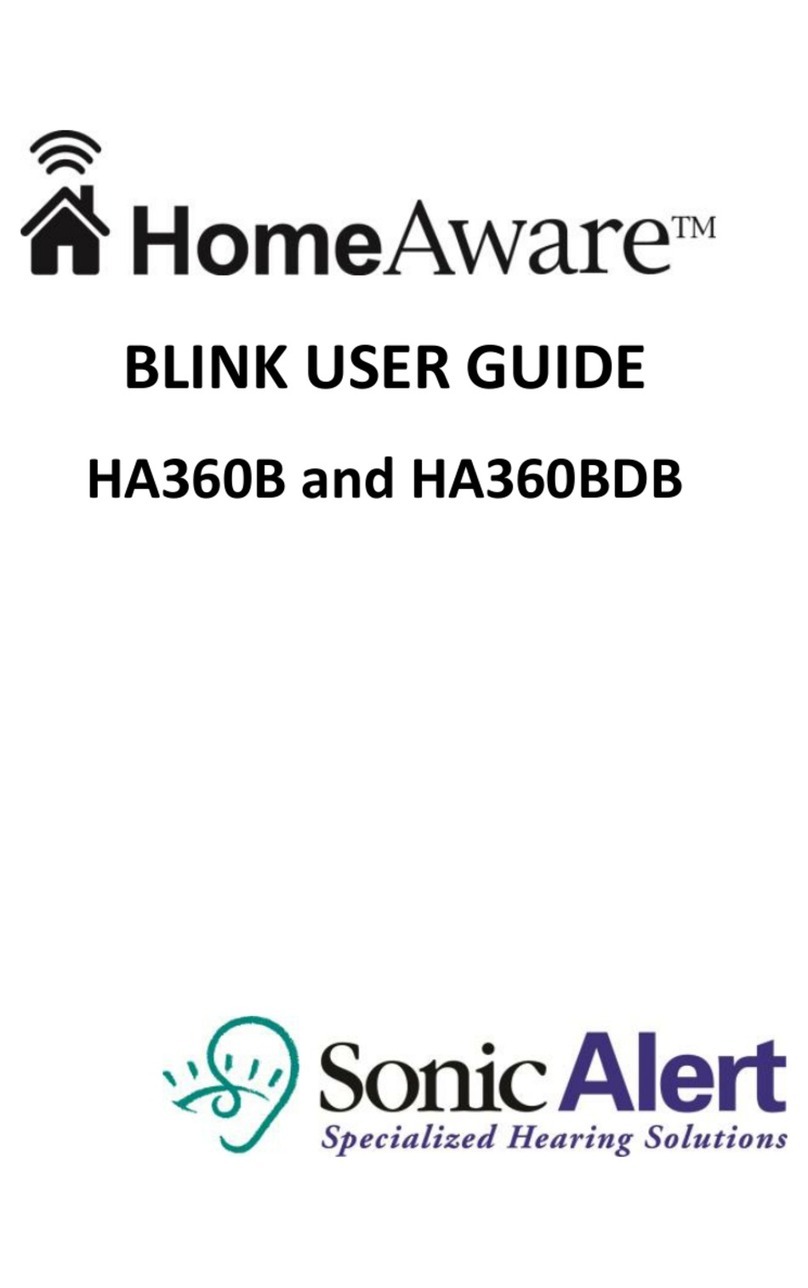
Sonic Alert
Sonic Alert HomeAware BLINK user guide
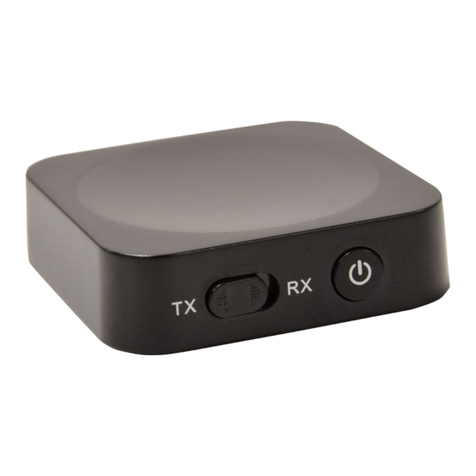
AVLink
AVLink 100.596UK user manual
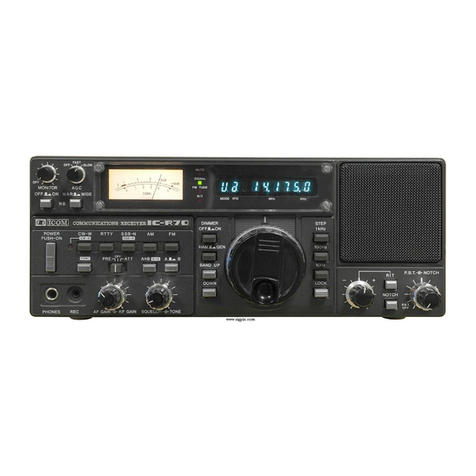
Icom
Icom IC-R70 Maintenance manual
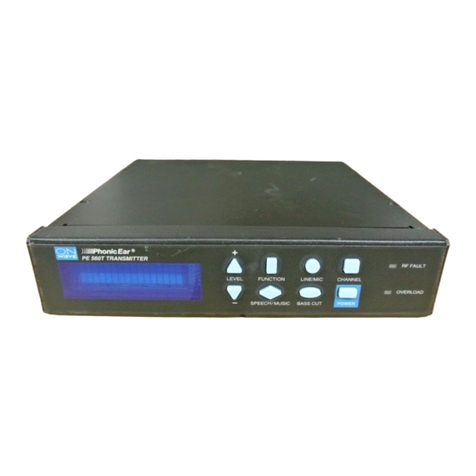
Phonic Ear
Phonic Ear OnWave user guide
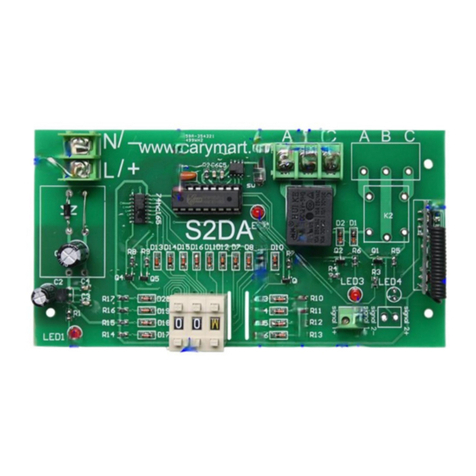
SHENZHEN GUIYUAN INDUSTRY DEVELOPMENT
SHENZHEN GUIYUAN INDUSTRY DEVELOPMENT S1DA-DC06 manual
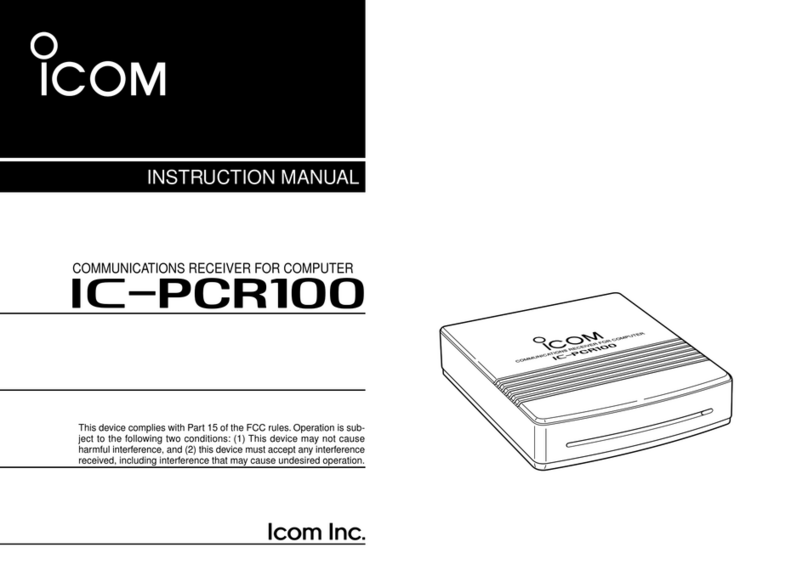
Icom
Icom COMMUNICATION RECEIVER IC PCR100 instruction manual
